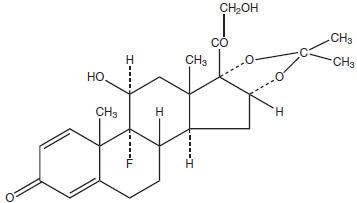Pediaderm TA Cream
Generic name:triamcinolone acetonide
Dosage form: cream
Drug class:Topical steroids
Medically reviewed by Drugs.com. Last updated on Sep 21, 2021.
On This Page
Rx only
The Pediaderm TA brand name has been discontinued in the U.S. If generic versions of this product have been approved by the FDA, there may be generic equivalents available.
Pediaderm TA Cream Description
The topical corticosteroids constitute a class of primarily synthetic steroids used as anti-inflammatory and antipruritic agents. The steroids in this class include Triamcinolone Acetonide. Triamcinolone Acetonide is designated chemically as 9-Fluoro-11β,16α,17,21-tetrahydroxypregna-1,4-diene-3,20-dione cyclic 16,17-acetal with acetone. With the molecular formula of C24H31FO6 and a molecular weight of 434.51. The structural formula is:

Each gram of Triamcinolone Acetonide Cream USP, 0.1% contains 1 mg Triamcinolone Acetonide in a cream base consisting of cetyl alcohol, cetyl esters wax, glyceryl monostearate, isopropyl palmitate, polysorbate-60, polysorbate-80, propylene glycol and purified water.
Pediaderm TA Cream - Clinical Pharmacology
Topical corticosteroids share anti-inflammatory, antipruritic and vasoconstrictive actions.
The mechanism of anti-inflammatory activity of topical corticosteroids is unclear. Various laboratory methods, including vasoconstrictor assays, are used to compare and predict potencies and/or clinical efficacies of the topical corticosteroids. There is some evidence to suggest that a recognizable correlation exists between vasoconstrictor potency and therapeutic efficacy in man.
Pharmacokinetics
The extent of percutaneous absorption of topical corticosteroids is determined by many factors including the vehicle, the integrity of the epidermal barrier, and the use of occlusive dressings.
Topical corticosteroids can be absorbed from normal intact skin. Inflammation and/or other disease processes in the skin increase percutaneous absorption. Occlusive dressings substantially increase the percutaneous absorption of topical corticosteroids. Thus, occlusive dressings may be a valuable therapeutic adjunct for treatment of resistant dermatoses ...



